1、认识应用状态管理
1.1、什么是状态管理
在开发中,我们会的应用程序需要处理各种各样的数据,这些数据需要保存在我们应用程序中的某一个位置,对于这些数据的管理我们就称之为是 状态管理。
在前面我们是如何管理自己的状态呢?
- 在Vue开发中,我们使用组件化的开发方式;
- 而在组件中我们定义data或者在setup中返回使用的数据,这些数据我们称之为state;
- 在模块template中我们可以使用这些数据,模块最终会被渲染成DOM,我们称之为View;
- 在模块中我们会产生一些行为事件,处理这些行为事件时,有可能会修改state,这些行为事件我们称之为actions;
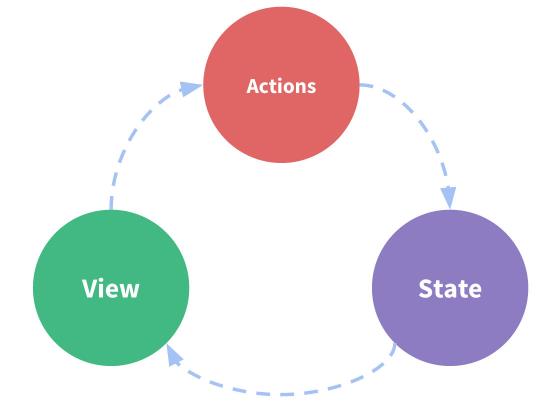
1.2、复杂的状态管理
JavaScript开发的应用程序,已经变得越来越复杂了:
- JavaScript需要管理的状态越来越多,越来越复杂;
- 这些状态包括服务器返回的数据、缓存数据、用户操作产生的数据等等;
- 也包括一些UI的状态,比如某些元素是否被选中,是否显示加载动效,当前分页;
当我们的应用遇到多个组件共享状态时,单向数据流的简洁性很容易被破坏:
- 多个视图依赖于同一状态;
- 来自不同视图的行为需要变更同一状态;
我们是否可以通过组件数据的传递来完成呢?
- 对于一些简单的状态,确实可以通过props的传递或者Provide的方式来共享状态;
- 但是对于复杂的状态管理来说,显然单纯通过传递和共享的方式是不足以解决问题的,比如兄弟组件如何共享数据呢?
1.3、Vuex的状态管理
管理不断变化的state本身是非常困难的:
- 状态之间相互会存在依赖,一个状态的变化会引起另一个状态的变化,View页面也有可能会引起状态的变化;
- 当应用程序复杂时,state在什么时候,因为什么原因而发生了变化,发生了怎么样的变化,会变得非常难以控制和追踪;
因此,我们是否可以考虑将组件的内部状态抽离出来,以一个全局单例的方式来管理呢?
- 在这种模式下,我们的组件树构成了一个巨大的 “视图View”;
- 不管在树的哪个位置,任何组件都能获取状态或者触发行为;
- 通过定义和隔离状态管理中的各个概念,并通过强制性的规则来维护视图和状态间的独立性,我们的代码边会变得更加结构化和易于维护、跟踪;
这就是Vuex背后的基本思想,它借鉴了Flux、Redux、Elm(纯函数语言,redux有借鉴它的思想);
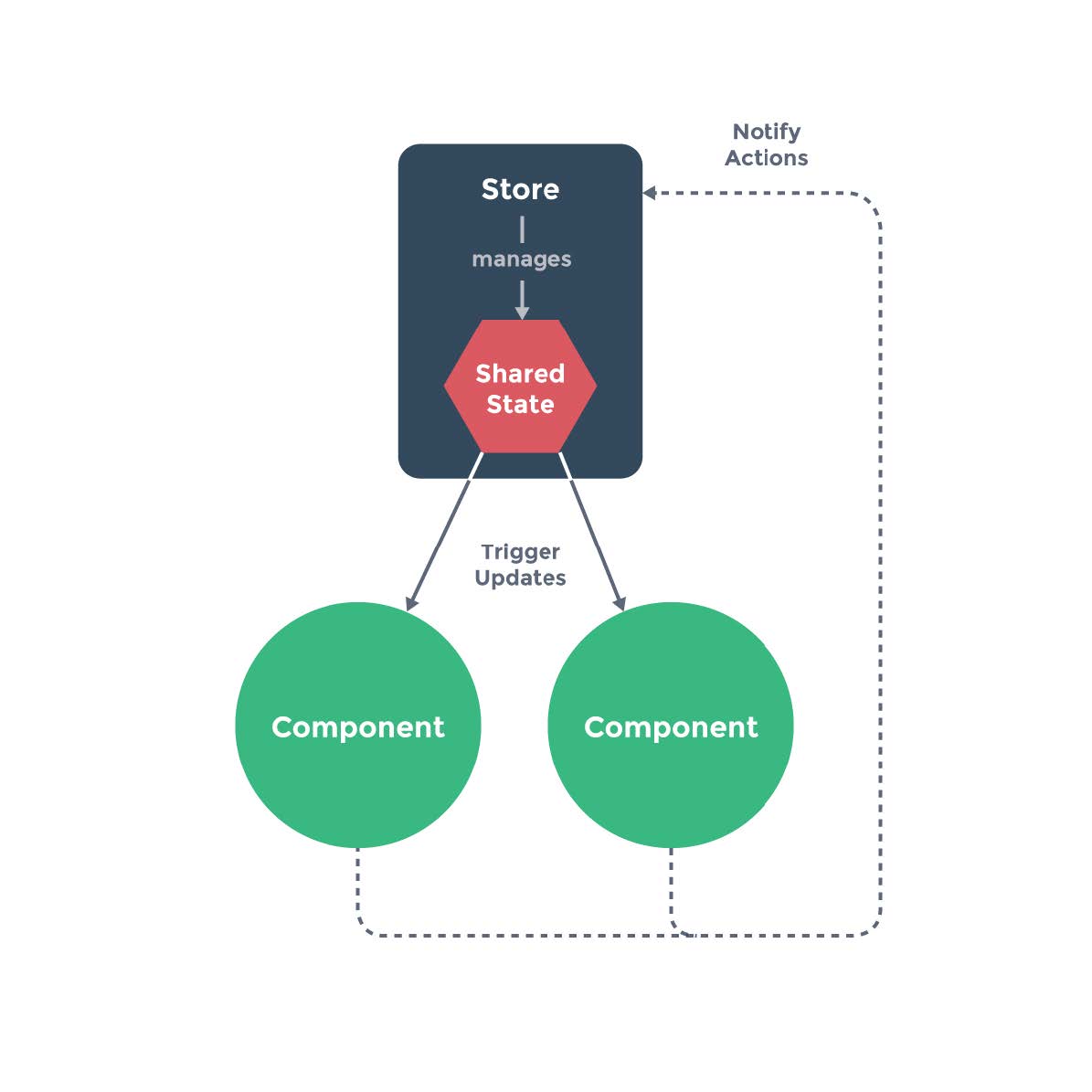

2、Vuex的基本使用
2.1、Vuex的安装
然我们要使用vuex,首先第一步需要安装vuex:我们这里使用的是vuex4.x;
npm install vuex
2.2、创建Store
每一个Vuex应用的核心就是store(仓库):
- store本质上是一个容器,它包含着你的应用中大部分的状态(state);
Vuex和单纯的全局对象有什么区别呢?
- 第一:Vuex的状态存储是响应式的
- 当Vue组件从store中读取状态的时候,若store中的状态发生变化,那么相应的组件也会被更新;
- 第二:你不能直接改变store中的状态
- 改变store中的状态的唯一途径就显示提交 (commit) mutation;
- 这样使得我们可以方便的跟踪每一个状态的变化,从而让我们能够通过一些工具帮助我们更好的管理应用的状态;
使用步骤:
- 创建Store对象;
- 在app中通过插件安装;
- 调用
2.3、组件中使用store
在组件中使用store,我们按照如下的方式:
- 在模板中使用;
- 在options api中使用,比如computed;
- 在setup中使用;
2.4、示例代码
index.js(创建store对象)
import { createStore } from 'vuex'
// 创建store对象,向里面添加值
const store = createStore({
state: () => ({
counter: 100,
}),
// 数据修改操作
mutations: {
increment(state) {
state.counter++
}
}
})
export default store
Home.vue
<template>
<div class="app">
<h2>Home当前计数: {{ $store.state.counter }}</h2>
<h2>Computed当前计数: {{ storeCounter }}</h2>
<h2>Setup当前计数: {{ counter }}</h2>
<button @click="increment">+1</button>
</div>
</template>
<!--vue支持使用多个script标签-->
<script>
// 使用option api方式获取vuex中保存的值
export default {
computed: {
storeCounter() {
return this.$store.state.counter
}
}
}
</script>
<script setup>
import {toRefs} from 'vue'
import {useStore} from 'vuex'
// 获取store对象
const store = useStore()
// store对象解构后数据就不是响应式了,所以我们可以使用toRefs对其包裹,这时候数据就又是响应式了
const {counter} = toRefs(store.state) // 返回的是Promise对象
function increment() {
// store.state.counter++ // 不能使用这种方式对数据进行修改(虽然能够修改成功),必须要通过mutation进行数据修改
store.commit("increment") // 这个字符串是我们store里面mutation所设置的属性名称
}
</script>
<style scoped>
</style>
App.vue
<template>
<div class="app">
<!-- store中的counter -->
<!--在组件中使用 $store.state.属性名 获取值-->
<h2>App当前计数: {{ $store.state.counter }}</h2>
<hr>
<!-- home页面 -->
<home/>
</div>
</template>
<script setup>
// 导入Home组件
import Home from './views/Home.vue'
</script>
<style>
</style>
main.js
import { createApp } from 'vue'
import App from './App.vue'
// 导入我们暴露的store对象
import store from './store'
createApp(App).use(store).mount('#app')
3、核心概念State
3.1、单一状态树
Vuex 使用单一状态树:
- 用一个对象就包含了全部的应用层级的状态;
- 采用的是SSOT,Single Source of Truth,也可以翻译成单一数据源;
这也意味着,每个应用将仅仅包含一个 store 实例;
- 单状态树和模块化并不冲突;
单一状态树的优势:
- 如果你的状态信息是保存到多个Store对象中的,那么之后的管理和维护等等都会变得特别困难;
- 所以Vuex也使用了单一状态树来管理应用层级的全部状态;
- 单一状态树能够让我们最直接的方式找到某个状态的片段;
- 而且在之后的维护和调试过程中,也可以非常方便的管理和维护;
3.2、组件获取状态
在前面我们已经学习过如何在组件中获取状态了。
当然,如果觉得那种方式有点繁琐(表达式过长),我们可以使用计算属性:

但是,如果我们有很多个状态都需要获取话,可以使用mapState的辅助函数:
- mapState的方式一:对象类型;
- mapState的方式二:数组类型;
- 也可以使用展开运算符和来原有的computed混合在一起
3.3、在setup中使用mapState
在setup中如果我们单个获取装是非常简单的:
- 通过useStore拿到store后去获取某个状态即可;
- 但是如果我们需要使用 mapState 的功能呢?
默认情况下,Vuex并没有提供非常方便的使用mapState的方式,这里我们进行了一个函数的封装:
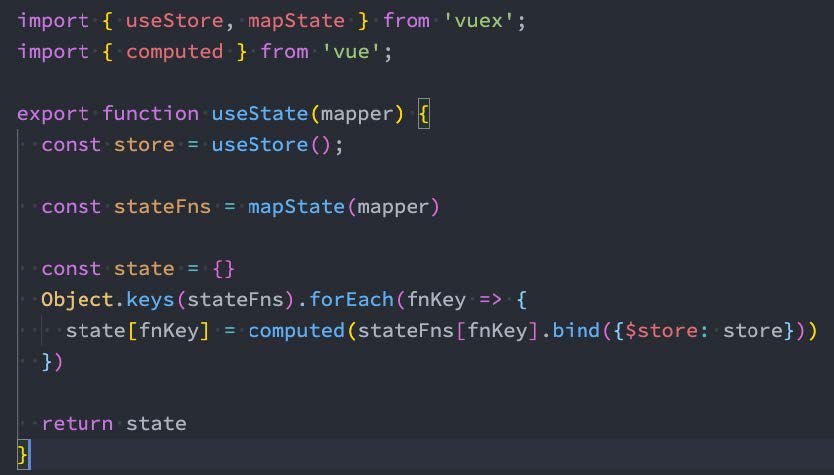
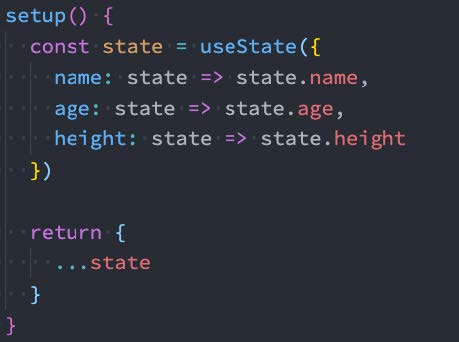
3.4、代码示例
index.js
import { createStore } from 'vuex'
const store = createStore({
state: () => ({
counter: 100,
name: "coderwhy",
level: 100,
avatarURL: "http://xxxxxx",
}),
// 数据修改操作
mutations: {
increment(state) {
state.counter++
}
}
})
export default store
Home.vue
<template>
<div class="app">
<button @click="incrementLevel">修改level</button>
<!-- 1.在模板中直接使用多个状态 -->
<h2>name: {{ $store.state.name }}</h2>
<h2>level: {{ $store.state.level }}</h2>
<h2>avatar: {{ $store.state.avatarURL }}</h2>
<!-- 2.计算属性(映射状态: 数组语法) -->
<!-- <h2>name: {{ name }}</h2>
<h2>level: {{ level }}</h2> -->
<!-- 3.计算属性(映射状态: 对象语法) -->
<!-- <h2>name: {{ sName }}</h2>
<h2>level: {{ sLevel }}</h2> -->
<!-- 4.setup计算属性(映射状态: 对象语法) -->
<!-- <h2>name: {{ cName }}</h2>
<h2>level: {{ cLevel }}</h2> -->
<!-- 5.setup计算属性(映射状态: 对象语法) -->
<h2>name: {{ name }}</h2>
<h2>level: {{ level }}</h2>
</div>
</template>
<script>
import {mapState} from 'vuex'
export default {
computed: {
/* fullname() {
return "xxx"
},*/
// name() {
// return this.$store.state.name
// },
// mapState映射函数,使用展开运算符,返回的是一个个的函数,函数名就是数组里面的元素名
// 传入数组
...mapState(["name", "level", "avatarURL"]),
// 传入对象
...mapState({
sName: state => state.name,
sLevel: state => state.level
})
}
}
</script>
<script setup>
import {computed, toRefs} from 'vue'
import {mapState, useStore} from 'vuex'
import useState from "../hooks/useState"
// 1.一步步完成
// 对返回的对象进行结构
// const { name, level } = mapState(["name", "level"])
// const store = useStore()
// 绑定对象
// const cName = computed(name.bind({ $store: store }))
// const cLevel = computed(level.bind({ $store: store }))
// 2.使用useState(将上述代码,进行封装的函数)
// computed对象解构出来的数据依旧是响应式的
// const { name, level } = useState(["name", "level"])
// 3.直接对store.state进行解构(推荐)
const store = useStore()
// 数据不是响应式的所以需要toRefs进行包裹
const {name, level} = toRefs(store.state)
// 违背vuex修改数据原则,这里只是为了方便测试数据是否是响应式的,实际开发必须要在mutation中进行修改
function incrementLevel() {
store.state.level++
}
</script>
<style scoped>
</style>
自己封装的useState.js
import { computed } from 'vue'
import { useStore, mapState } from 'vuex'
export default function useState(mapper) {
const store = useStore()
const stateFnsObj = mapState(mapper)
const newState = {}
Object.keys(stateFnsObj).forEach(key => {
newState[key] = computed(stateFnsObj[key].bind({ $store: store }))
})
return newState
}
注意:App.vue 与 main.js代码都未发生改变所以省略(下面的示例代码都会省略)
4、核心概念Getters
4.1、getters的基本使用
某些属性我们可能需要经过变化后来使用,这个时候可以使用getters:


4.2、getters第二个参数
getters可以接收第二个参数:

4.3、getters的返回函数
getters中的函数本身,可以返回一个函数,那么在使用的地方相当于可以调用这个函数:
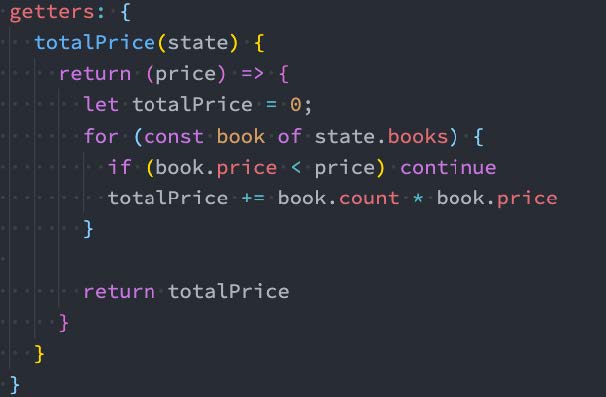
4.4、基本使用代码
index.js
import {createStore} from 'vuex'
const store = createStore({
state: () => ({
counter: 100,
name: "coderwhy",
level: 100,
avatarURL: "http://xxxxxx",
friends: [
{ id: 111, name: "why", age: 20 },
{ id: 112, name: "kobe", age: 30 },
{ id: 113, name: "james", age: 25 }
]
}),
// 对数据进行处理后才返回,类似于computed函数
getters: {
// 1.基本使用
doubleCounter(state) {
return state.counter * 2
},
totalAge(state) {
return state.friends.reduce((preValue, item) => {
return preValue + item.age
}, 0)
},
// 2.在该getters属性中, 获取其他的getters
message(state, getters) {
return `name:${state.name} level:${state.level} friendTotalAge:${getters.totalAge}`
},
// 3.getters是可以返回一个函数的, 调用这个函数可以传入参数(了解)
getFriendById(state) {
return function (id) {
return state.friends.find(item => item.id === id)
}
}
},
// 数据修改操作
mutations: {
increment(state) {
state.counter++
},
changeName(state, payload) {
state.name = payload
},
incrementLevel(state) {
state.level++
}
}
})
export default store
Home.vue
<template>
<div class="app">
<h2>doubleCounter: {{ $store.getters.doubleCounter }}</h2>
<h2>friendsTotalAge: {{ $store.getters.totalAge }}</h2>
<h2>message: {{ $store.getters.message }}</h2>
<!-- 根据id获取某一个朋友的信息 -->
<h2>id-111的朋友信息: {{ $store.getters.getFriendById(111) }}</h2>
<h2>id-112的朋友信息: {{ $store.getters.getFriendById(112) }}</h2>
</div>
</template>
<script>
export default {
computed: {}
}
</script>
<script setup>
</script>
<style scoped>
</style>
4.5、mapGetters的辅助函数
这里我们也可以使用mapGetters的辅助函数。

在setup中使用
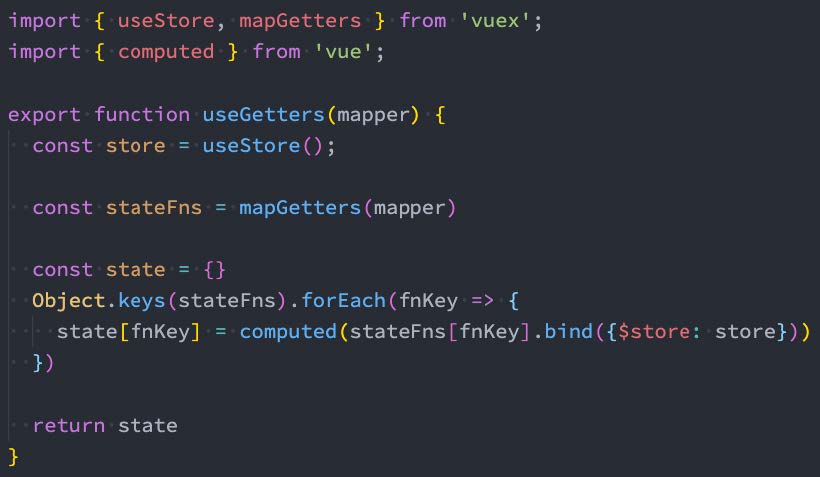
4.6、mapGetters映射示例代码
Home.vue
<template>
<div class="app">
<button @click="changeAge">修改name</button>
<h2>doubleCounter: {{ doubleCounter }}</h2>
<h2>friendsTotalAge: {{ totalAge }}</h2>
<h2>message: {{ message }}</h2>
<!-- 根据id获取某一个朋友的信息 -->
<h2>id-111的朋友信息: {{ getFriendById(111) }}</h2>
<h2>id-112的朋友信息: {{ getFriendById(112) }}</h2>
</div>
</template>
<script>
import {mapGetters} from 'vuex'
export default {
computed: {
...mapGetters(["doubleCounter", "totalAge"]),
...mapGetters(["getFriendById"])
}
}
</script>
<script setup>
import {computed, toRefs} from 'vue';
import {mapGetters, useStore} from 'vuex'
const store = useStore()
// 1.使用mapGetters,得到的是一个message函数,对其取别名为messageFn
// const { message: messageFn } = mapGetters(["message"])
// const message = computed(messageFn.bind({ $store: store }))
// 2.直接解构, 并且包裹成ref
// const { message } = toRefs(store.getters)
// 3.针对某一个getters属性使用computed
const message = computed(() => store.getters.message)
function changeAge() {
store.state.name = "kobe"
}
</script>
<style scoped>
</style>
5、核心概念Mutations
5.1、Mutation基本使用
更改 Vuex 的 store 中的状态的唯一方法是提交 mutation:
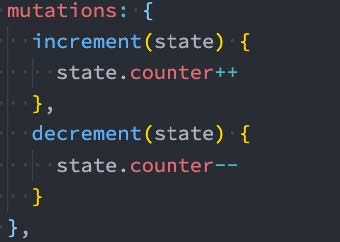
5.2、Mutation携带数据
很多时候我们在提交mutation的时候,会携带一些数据,这个时候我们可以使用参数:

payload为对象类型

对象风格的提交方式
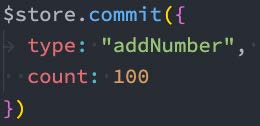
5.3、Mutation常量类型
定义常量:mutation-type.js

定义mutation

提交mutation

5.4、mapMutations辅助函数
我们也可以借助于辅助函数,帮助我们快速映射到对应的方法中:

在setup中使用也是一样的:

5.5、mutation重要原则
一条重要的原则就是要记住 mutation 必须是同步函数
- 这是因为devtool工具会记录mutation的日记;
- 每一条mutation被记录,devtools都需要捕捉到前一状态和后一状态的快照;
- 但是在mutation中执行异步操作,就无法追踪到数据的变化;
所以Vuex的重要原则中要求 mutation必须是同步函数;
5.6、代码示例
index.js
import {createStore} from 'vuex'
import {CHANGE_INFO} from './mutation_types'
const store = createStore({
state: () => ({
counter: 100,
name: "coderwhy",
level: 100,
avatarURL: "http://xxxxxx",
friends: [
{ id: 111, name: "why", age: 20 },
{ id: 112, name: "kobe", age: 30 },
{ id: 113, name: "james", age: 25 }
]
}),
// 对数据进行处理后才返回,类似于computed函数
getters: {
// 1.基本使用
doubleCounter(state) {
return state.counter * 2
},
totalAge(state) {
return state.friends.reduce((preValue, item) => {
return preValue + item.age
}, 0)
},
// 2.在该getters属性中, 获取其他的getters
message(state, getters) {
return `name:${state.name} level:${state.level} friendTotalAge:${getters.totalAge}`
},
// 3.getters是可以返回一个函数的, 调用这个函数可以传入参数(了解)
getFriendById(state) {
return function (id) {
return state.friends.find(item => item.id === id)
}
}
},
// 数据修改操作
mutations: {
increment(state) {
state.counter++
},
changeName(state, payload) {
state.name = payload
},
incrementLevel(state) {
state.level++
},
// [导入的常量名]
[CHANGE_INFO](state, newInfo) {
state.level = newInfo.level
state.name = newInfo.name
// 重要的原则: 不要在mutation方法中执行异步操作
// fetch("xxxx").then(res => {
// res.json().then(res => {
// state.name = res.name
// })
// })
}
}
})
export default store
定义常量mutation_types.js
export const CHANGE_INFO = "changeInfo"基本使用:Home.vue
<template>
<div class="app">
<button @click="changeName">修改name</button>
<button @click="incrementLevel">递增level</button>
<button @click="changeInfo">修改info</button>
<h2>Store Name: {{ $store.state.name }}</h2>
<h2>Store Level: {{ $store.state.level }}</h2>
</div>
</template>
<script>
import {CHANGE_INFO} from "@/store/mutation_types"
export default {
computed: {},
methods: {
changeName() {
// this.$store.state.name = "李银河"
this.$store.commit("changeName", "王小波")
},
incrementLevel() {
this.$store.commit("incrementLevel")
},
changeInfo() {
this.$store.commit(CHANGE_INFO, {
name: "王二",
level: 200
})
}
}
}
</script>
<script setup>
</script>
<style scoped>
</style>
mapMutations映射:Home.vue
<template>
<div class="app">
<button @click="changeName('王小波')">修改name</button>
<button @click="incrementLevel">递增level</button>
<button @click="changeInfo({ name: '王二', level: 200 })">修改info</button>
<h2>Store Name: {{ $store.state.name }}</h2>
<h2>Store Level: {{ $store.state.level }}</h2>
</div>
</template>
<script>
import { mapMutations } from 'vuex'
import { CHANGE_INFO } from "@/store/mutation_types"
export default {
computed: {
},
methods: {
btnClick() {
console.log("btnClick")
},
// ...mapMutations(["changeName", "incrementLevel", CHANGE_INFO])
}
}
</script>
<script setup>
import { mapMutations, useStore } from 'vuex'
import { CHANGE_INFO } from "@/store/mutation_types"
const store = useStore()
// 1.手动的映射和绑定
const mutations = mapMutations(["changeName", "incrementLevel", CHANGE_INFO])
const newMutations = {}
Object.keys(mutations).forEach(key => {
newMutations[key] = mutations[key].bind({ $store: store })
})
const { changeName, incrementLevel, changeInfo } = newMutations
</script>
<style scoped>
</style>
6、核心概念Actions
6.1、actions的基本使用
Action类似于mutation,不同在于:
- Action提交的是mutation,而不是直接变更状态;
- Action可以包含任意异步操作;
这里有一个非常重要的参数context:
- context是一个和store实例均有相同方法和属性的context对象;
- 所以我们可以从其中获取到commit方法来提交一个mutation,或者通过 context.state 和 context.getters 来获取 state 和getters;
但是为什么它不是store对象呢?这个等到我们讲Modules时再具体来说;
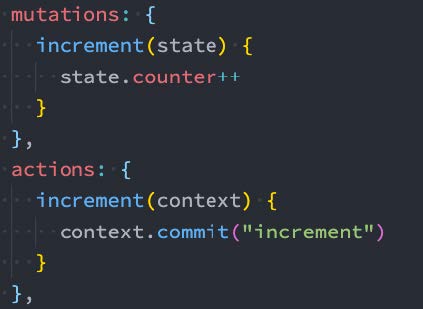
6.2、actions的分发操作
如何使用action呢?进行action的分发:
- 分发使用的是 store 上的dispatch函数;

同样的,它也可以携带我们的参数:

也可以以对象的形式进行分发:
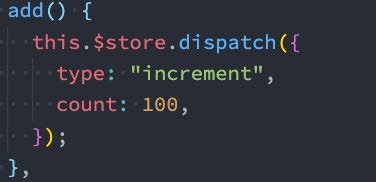
6.3、基本使用
index.js
import { createStore } from 'vuex'
const store = createStore({
state: () => ({
// 模拟数据
counter: 100,
name: "coderwhy",
}),
mutations: {
increment(state) {
state.counter++
},
changeName(state, payload) {
state.name = payload
}
},
actions: {
incrementAction(context) {
// console.log(context.commit) // 用于提交mutation
// console.log(context.getters) // getters
// console.log(context.state) // state
context.commit("increment")
},
changeNameAction(context, payload) {
context.commit("changeName", payload)
}
},
})
export default store
Home.vue
<template>
<div class="home">
<h2>当前计数: {{ $store.state.counter }}</h2>
<button @click="counterBtnClick">发起action修改counter</button>
<h2>name: {{ $store.state.name }}</h2>
<button @click="nameBtnClick">发起action修改name</button>
</div>
</template>
<script>
export default {
methods: {
counterBtnClick() {
this.$store.dispatch("incrementAction")
},
nameBtnClick() {
this.$store.dispatch("changeNameAction", "aaa")
}
}
}
</script>
<script setup>
</script>
<style scoped>
</style>
6.4、actions的辅助函数
action也有对应的辅助函数:
- 对象类型的写法;
- 数组类型的写法;


6.5、mapActions映射
Home.vue
<template>
<div class="home">
<h2>当前计数: {{ $store.state.counter }}</h2>
<button @click="incrementAction">发起action修改counter</button>
<button @click="increment">递增counter</button>
<h2>name: {{ $store.state.name }}</h2>
<button @click="changeNameAction('bbbb')">发起action修改name</button>
</div>
</template>
<script>
import {mapActions} from 'vuex'
export default {
methods: {
// counterBtnClick() {
// this.$store.dispatch("incrementAction")
// },
// nameBtnClick() {
// this.$store.dispatch("changeNameAction", "aaa")
// }
// ...mapActions(["incrementAction", "changeNameAction"])
}
}
</script>
<script setup>
import {useStore, mapActions} from 'vuex'
const store = useStore()
// 1.在setup中使用mapActions辅助函数
// const actions = mapActions(["incrementAction", "changeNameAction"])
// const newActions = {}
// Object.keys(actions).forEach(key => {
// newActions[key] = actions[key].bind({ $store: store })
// })
// const { incrementAction, changeNameAction } = newActions
// 2.使用默认的做法
function increment() {
store.dispatch("incrementAction")
}
</script>
<style scoped>
</style>
6.6、actions的异步操作
Action 通常是异步的,那么如何知道 action 什么时候结束呢?
- 我们可以通过让action返回Promise,在Promise的then中来处理完成后的操作;

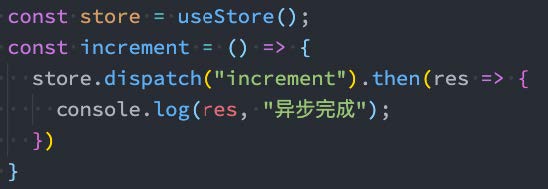
6.7、action发送网络请求
index.js
import { createStore } from 'vuex'
const store = createStore({
state: () => ({
// 服务器数据
banners: [],
recommends: []
}),
mutations: {
changeBanners(state, banners) {
state.banners = banners
},
changeRecommends(state, recommends) {
state.recommends = recommends
}
},
actions: {
fetchHomeMultidataAction(context) {
// 1.返回Promise, 给Promise设置then
// fetch("http://123.207.32.32:8000/home/multidata").then(res => {
// res.json().then(data => {
// console.log(data)
// })
// })
// 2.Promise链式调用
// fetch("http://123.207.32.32:8000/home/multidata").then(res => {
// return res.json()
// }).then(data => {
// console.log(data)
// })
return new Promise(async (resolve, reject) => {
// 3.await/async
const res = await fetch("http://123.207.32.32:8000/home/multidata")
const data = await res.json()
// 修改state数据
context.commit("changeBanners", data.data.banner.list)
context.commit("changeRecommends", data.data.recommend.list)
// 成功回调函数
resolve("aaaaa")
})
}
}
})
export default store
Home.vue
<template>
<div class="home">
<h2>Home Page</h2>
<ul>
<template v-for="item in $store.state.banners" :key="item.acm">
<li>{{ item.title }}</li>
</template>
</ul>
</div>
</template>
<script>
</script>
<script setup>
import { useStore } from 'vuex'
// 告诉Vuex发起网络请求
const store = useStore()
store.dispatch("fetchHomeMultidataAction").then(res => { // res就是我们resolve中传递过来的值
console.log("home中的then被回调:", res)
})
</script>
<style scoped>
</style>
7、核心概念Modules
7.1、module的基本使用
什么是Module?
- 由于使用单一状态树,应用的所有状态会集中到一个比较大的对象,当应用变得非常复杂时,store 对象就有可能变得相当臃肿;
- 为了解决以上问题,Vuex 允许我们将 store 分割成模块(module);
- 每个模块拥有自己的 state、mutation、action、getter、甚至是嵌套子模块;
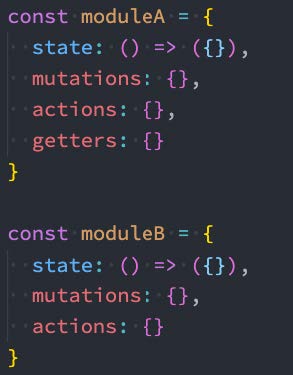

示例代码
index.js
import {createStore} from 'vuex'
import homeModule from './modules/home'
import counterModule from './modules/counter'
const store = createStore({
state: () => ({
// 服务器数据
// banners: [],
// recommends: []
}),
getters: {},
mutations: {},
actions: {},
// 导入外部模块
modules: {
home: homeModule,
counter: counterModule
}
})
export default store
home.js
export default {
state: () => ({
// 服务器数据
banners: [],
recommends: []
}),
mutations: {
changeBanners(state, banners) {
state.banners = banners
},
changeRecommends(state, recommends) {
state.recommends = recommends
}
},
actions: {
fetchHomeMultidataAction(context) {
return new Promise(async (resolve, reject) => {
// 3.await/async
const res = await fetch("http://123.207.32.32:8000/home/multidata")
const data = await res.json()
// 修改state数据
context.commit("changeBanners", data.data.banner.list)
context.commit("changeRecommends", data.data.recommend.list)
resolve("aaaaa")
})
}
}
}
Home.vue
<template>
<div class="home">
<h2>Home Page</h2>
<ul>
<!-- 获取数据: 需要从模块中获取 state.modulename.xxx -->
<template v-for="item in $store.state.home.banners" :key="item.acm">
<li>{{ item.title }}</li>
</template>
</ul>
</div>
</template>
<script>
</script>
<script setup>
import { useStore } from 'vuex'
// 告诉Vuex发起网络请求
const store = useStore()
store.dispatch("fetchHomeMultidataAction").then(res => {
console.log("home中的then被回调:", res)
})
</script>
<style scoped>
</style>
7.2、module的局部状态
对于模块内部的 mutation 和 getter,接收的第一个参数是模块的局部状态对象:


7.3、默认模块化
counter.js
const counter = {
state: () => ({
count: 99
}),
mutations: {
incrementCount(state) {
console.log(state)
state.count++
}
},
getters: {
doubleCount(state, getters, rootState) { // rootState为根状态
return state.count + rootState.rootCounter
}
},
actions: {
incrementCountAction(context) {
context.commit("incrementCount")
}
}
}
export default counter
Home.vue
<template>
<div class="home">
<h2>Home Page</h2>
<!-- 1.使用state时, 是需要state.moduleName.xxx -->
<h2>Counter模块的counter: {{ $store.state.counter.count }}</h2>
<!-- 2.使用getters时, 是直接getters.xxx -->
<h2>Counter模块的doubleCounter: {{ $store.getters.doubleCount }}</h2>
<button @click="incrementCount">count模块+1</button>
</div>
</template>
<script>
</script>
<script setup>
import {useStore} from 'vuex'
// 告诉Vuex发起网络请求
const store = useStore()
// 派发事件时, 默认也是不需要跟模块名称
// 提交mutation时, 默认也是不需要跟模块名称
function incrementCount() {
store.dispatch("incrementCountAction")
}
</script>
<style scoped>
</style>
7.4、module的命名空间
默认情况下,模块内部的action和mutation仍然是注册在全局的命名空间中的:
- 这样使得多个模块能够对同一个 action 或 mutation 作出响应;
- Getter 同样也默认注册在全局命名空间;
如果我们希望模块具有更高的封装度和复用性,可以添加 namespaced: true 的方式使其成为带命名空间的模块:
- 当模块被注册后,它的所有 getter、action 及 mutation 都会自动根据模块注册的路径调整命名;
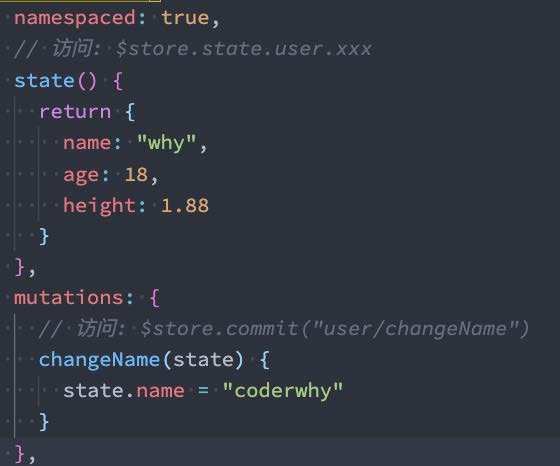
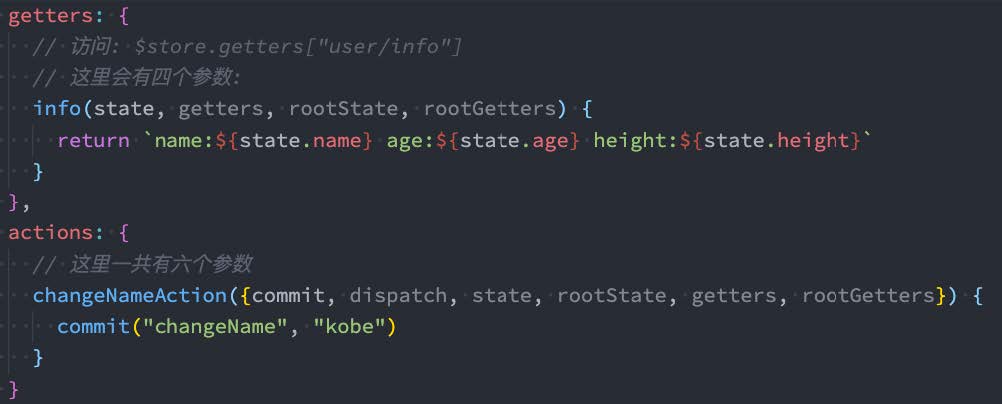
示例代码
counter.js
const counter = {
// ==========关键=================
namespaced: true,
// ==========关键=================
state: () => ({
count: 99
}),
mutations: {
incrementCount(state) {
console.log(state)
state.count++
}
},
getters: {
doubleCount(state, getters, rootState) {
return state.count + rootState.rootCounter
}
},
actions: {
incrementCountAction(context) {
context.commit("incrementCount")
}
}
}
export default counter
Home.vue
<template>
<div class="home">
<h2>Home Page</h2>
<!-- 1.使用state时, 是需要state.moduleName.xxx -->
<h2>Counter模块的counter: {{ $store.state.counter.count }}</h2>
<!-- 2.使用getters时, 不能直接使用getters.xxx 这种方式了,因为我们配置了名称空间-->
<h2>Counter模块的doubleCounter: {{ $store.getters["counter/doubleCount"] }}</h2>
<button @click="incrementCount">count模块+1</button>
</div>
</template>
<script>
</script>
<script setup>
import {useStore} from 'vuex'
// 告诉Vuex发起网络请求
const store = useStore()
// 派发事件时, 默认也是不需要跟模块名称
// 提交mutation时, 默认也是不需要跟模块名称
function incrementCount() {
// 注意这里与以前的改变
store.dispatch("counter/incrementCountAction")
}
</script>
<style scoped>
</style>
7.5、module修改或派发根组件
如果我们希望在action中修改root中的state,那么有如下的方式:
























 572
572

 被折叠的 条评论
为什么被折叠?
被折叠的 条评论
为什么被折叠?










